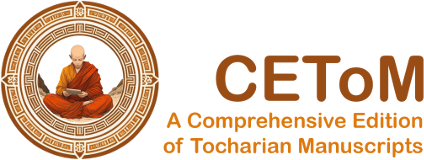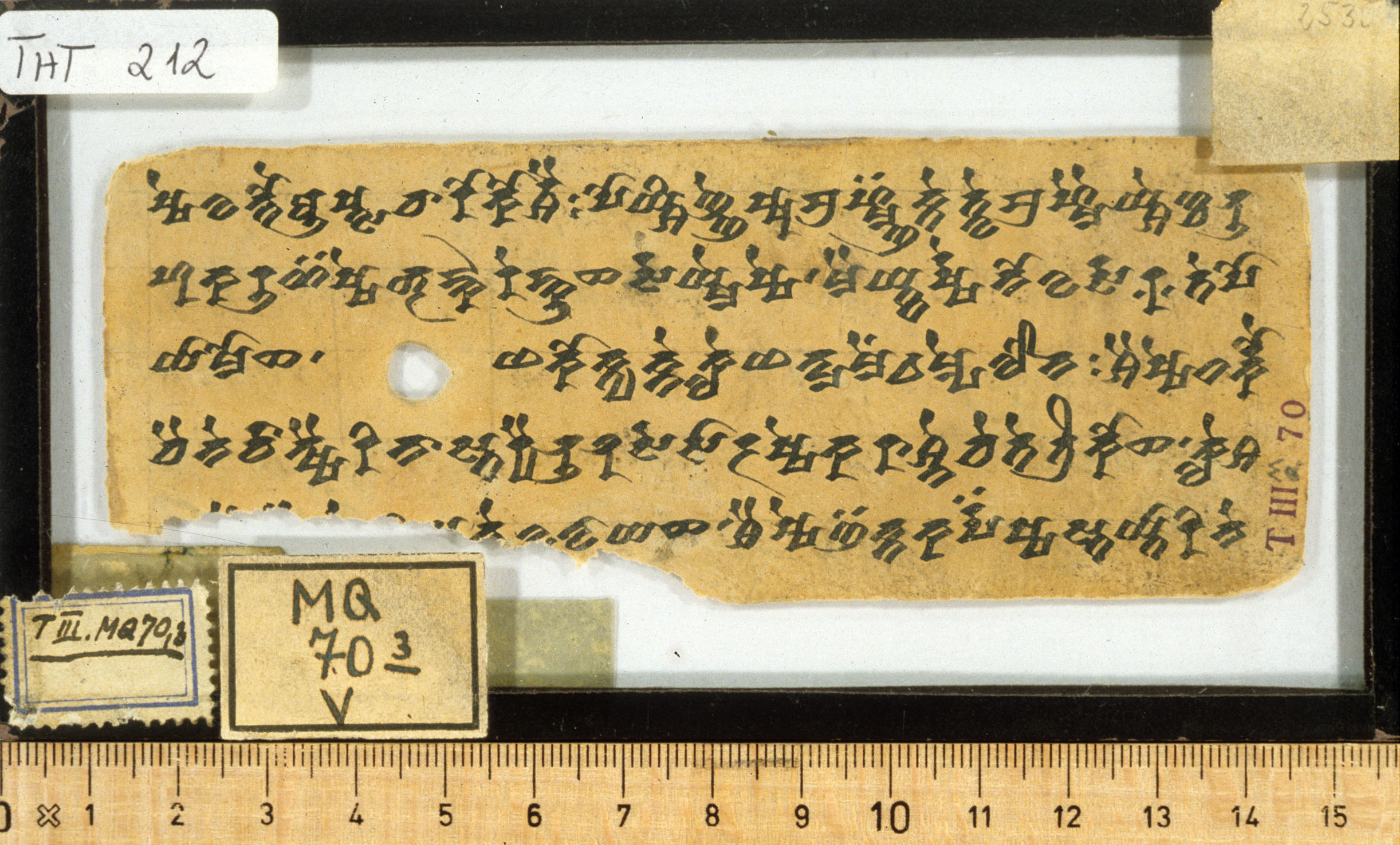THT 212
| Known as: | THT 212; B 212; Bleistiftnummer 2532 |
|---|---|
| Cite this page as: | Adrian Musitz (translation). "THT 212". In A Comprehensive Edition of Tocharian Manuscripts (CEToM). Created and maintained by Melanie Malzahn, Martin Braun, Hannes A. Fellner, and Bernhard Koller. https://cetom.univie.ac.at/?m-tht212 (accessed 12 Jul. 2025). |
Edition | |
| Editor: | Adrian Musitz (translation) |
Provenience | |
| Main find spot: | Kizil Ming-öy |
| Expedition code: | T III MQ 70.3 |
| Collection: | Berlin Turfan Collection |
Language and Script | |
| Language: | TB |
| Linguistic stage: | classical |
| Add. linguistic characteristics: | archaic |
| Script: | classical |
Text contents | |
| Text genre: | Literary |
| Text subgenre: | Buddhastotra |
| Verse/Prose: | verse |
| Meter: | 444 (4x) |
Object | |
| Manuscript: | THT 210-214 |
| Material: | ink on paper |
| Form: | Poṭhī |
| Number of lines: | 5 |
Images
Images from idp.bl.uk by courtesy of the International Dunhuang Project, the Berlin-Brandenburgische Akademie der Wissenschaften, and the Staatsbibliothek zu Berlin – Orientabteilung.
Transliteration
| a1 | ṣṣe wa ntau ā ṣtsa cā ro ko rśai : po yśi ññe ṣṣu bra hmñä kte twe bra hmai yśe ñca 70 |
|---|---|
| a2 | 8 ka ru ṇä ṣṣe bhṛ ṅkā re ṅku s̝a rsa yme ṣṣe • mai ytta rṣṣe no wa rsa ī te po |
| a3 | yā mo s̝a • śa ko ktya kne kle śa nma meṃ e mpe lo na : śai ṣṣe ta rkau |
| a4 | cai ne rvā nṣṣai ri nā sta ryai 70 9 s[aṃ] sā ra ṣṣe ka rā śne ce te tri ko s̝a • kle śa |
| a5 | – – – – – – [n]e wa wā ya s̝a • śai ṣṣe ñä kta ka rpä ṣṣa sta ytā ri ne |
| lf | 70 2 |
| b1 | – – – – – – – ·t· n· stw· r· śne rvvāṃ ṣṣai 80 śa ko ktya kne kle śa nma ṣṣeṃ te |
| b2 | ka nma sa • śai ṣṣā lā ṣmo lau ka ññe ṣai snai ysa ntkī naṃ¯ ¯nt ta ryā ka ṣū¯ ¯kt sāṃ tke |
| b3 | nta mpa trai ywa tai twe • sāṃ tko nwa ññe swā reṃ kre¯ ¯nt pe lai ykne ṣṣe 80-1 ke tai |
| b4 | tyo ktsi sāṃ tko nwa ññe pe lai ykne ṣṣe lyai tkeṃ te ki ma nta nta s̝a¯ ¯p sru ke nta rcai • kle |
| b5 | śa nma ṣṣeṃ te ka nma po la ma ṣṣe ñcai • po yśi ññe ṣṣu sāṃ tki nau twe ka rsau śā stra 80 2 |
Transcription
| lf | 70-2 |
| 70c | 3σ a1 ṣṣe ; wantau āṣtsa ; cāro-korśai : |
|---|---|
| 78d | poyśiññeṣṣu ; brahm-ñäkte twe ; brahm aiyśeñca 70 a2 8 |
| 79a | karuṇäṣṣe ; bhṛṅkār eṅku ; ṣärsa ymeṣṣe • |
| 79b | maiyttärṣṣe no ; warsa īte ; po a3 yāmoṣä • |
| 79c | śäk okt yakne ; kleśänmameṃ ; empelona : |
| 79d | śaiṣṣe tärkau;a4cai nervānṣṣai ; rin= āstaryai 70-9 |
| 80a | saṃsāräṣṣe ; karāśne ce ; tetrikoṣä • |
| 80b | kleśa a5 – – – – – – ne ; wawāyaṣä • |
| 80c | śaiṣṣe ñäkta ; karpäṣṣasta ; ytārine b1 – |
| 80d | – – – – – – ·t· n(e)s= tw(e) ; r(i)ś nervvāṃṣṣai 80 |
| 81a | śak okt yakne ; kleśanmaṣṣeṃ ; teb2känmasa • |
| 81b | śaiṣṣ-ālāṣmo ; laukäññe ṣai ; snaiy santkīnaṃnt |
| 81c | täryāka ṣūkt ; sāṃtkeb3ntampa ; traiywatai twe • |
| 81d | sāṃtk= onwaññe ; swāreṃ krent ; pelaiykneṣṣe 80-1 |
| 82a | ket aib4t yoktsi ; sāṃtk= onwaññe ; pelaiykneṣṣe |
| 82b | lyaitkeṃ teki ; mantanta ṣäp ; srukentär cai • |
| 82c | kleb5śanmaṣṣeṃ ; tekänma po ; lämäṣṣeñcai • |
| 82d | poyśiññeṣṣu ; sāṃtkinau twe ; kärsau śāsträ 80-2 |
Translation
| a1 | ... having wrapped a turban on his head ... All knowing one, you, Brahma-god, are one who knows brahma. |
|---|---|
| a2 | You, who, having seized the vessel of compassion with the hand of your mind, all filled with the water of friendship, let go the world from the terrible Kleśas of eighteen kinds into the pure town of Nirvāṇa! |
| a4 | Lord, you made this world that is lost in the wilderness of samsāra, brought... Kleśa..., descend onto the (right) way. |
| b1 | You are... to the town of Nirvāṇa. |
| b1+ | The world has long been sick with the diseases of the Kleśas of eighteen kinds, without a doctor . |
| b2+ | With thirty seven medicines, you mixed together the sweet, wholesome immortal medicine that is the law. |
| b3+ | Whoever you give the immortal medicine that is the law to drink, they will avert illness and they never die. |
| b4+ | You who makes subside all diseases of the Kleśas, all-knowing one, you are the doctor who knows the teaching. |
Other
| b2+ | Mit den siebenunddreißig Heilmitteln hast du das süße Aṃrta-Heilmittel des guten Gesetzes gemischt. (Schmidt 1974: 459) |
|---|---|
| b3+ | Whom you give the nectar medicine of the law to drink, they will remove illness and never die. (Peyrot 2013b: 703) |
| b3+ | Denen du als Heilmittel den Gesetzesnektar zu trinken geben wirst, die werden die Krankheit entfernen und sterben niemals. (Schmidt 1974: 115) |
References
Online access
Edition
Translations
Carling 2000: a4 a5 (95, 112), a4 a5 (96), b1 (402); Couvreur 1954c: a1 a2 a3 a4 a5 b1 b2 b3 b4 b5 (108); Hackstein 1995: b2 b3 (345); Krause 1952: a3 a4 (45), a4 (177), b4 (127); Peyrot 2013b: b3 b4 (703); Schmidt 1974: b2 b3 (459), b3 b4 (115); Thomas 1954: b3 b4 (724), b3 b4 (726); Thomas 1957: a3 a4 a5 (174), b2 b3 (174); Thomas 1969: a1 (238); Thomas 1997: a2 a3 a4 a5 (119), b4 b5 (100)
Bibliography
Carling, Gerd. 2000. Die Funktion der lokalen Kasus im Tocharischen. Berlin/New York: de Gruyter.
Couvreur, Walter. 1954c. “Koetsjische literaire fragmenten uit de Berlijnse verzameling (naar aanleiding van Sieg & Siegling’s Tocharische Sprachreste).” Handelingen VIII der Zuidnederlandse Maatschappij voor Taal- en Letterkunde en Geschiedenis, 97–117.
Hackstein, Olav. 1995. Untersuchungen zu den sigmatischen Präsensstammbildungen des Tocharischen. HS Erg.-Heft 38. Göttingen: Vandenhoeck & Ruprecht.
“The International Dunhuang Project: The Silk Road Online.” n.d. http://idp.bl.uk.
Krause, Wolfgang. 1952. Westtocharische Grammatik, Band I. Das Verbum. Heidelberg: Winter.
Peyrot, Michaël. 2013b. The Tocharian subjunctive. A study in syntax and verbal stem formation. Vol. 8. Brill’s Studies in Indo-European Languages & Linguistics. Leiden/Boston: Brill.
Schmidt, Klaus T. 1974. “Die Gebrauchsweisen des Mediums im Tocharischen.” PhD, Universität Göttingen.
Sieg, Emil, and Wilhelm Siegling. 1953. Tocharische Sprachreste. Sprache B, Heft 2. Fragmente Nr. 71-633. Edited by Werner Thomas. Göttingen: Vandenhoeck & Ruprecht.
Thomas, Werner. 1954. “Die Infinitive im Tocharischen.” In Asiatica. Festschrift Friedrich Weller. Zum 65. Geburtstag, gewidmet von seinen Freunden, Kollegen und Schülern, edited by Johannes Schubert and Ulrich Schneider, 701–64. Leipzig: Harrassowitz.
Thomas, Werner. 1957. Der Gebrauch der Vergangenheitstempora im Tocharischen. Wiesbaden: Harrassowitz.
Thomas, Werner. 1969. “Bemerkungen zum Gebrauch von toch. A ptāñkät [B pañäkte, pudñäkte], A koṃ [B kauṃ]: A koṃñkät [B kauṃñäkte] usw.” Orbis 18: 235–68.
Thomas, Werner. 1997. Interpretationsprobleme im Tocharischen. Unflektiertes A puk, B po “ganz, all, jeder”. Vol. 3. SbWGF, XXXV. Stuttgart: Steiner.
Gippert, Jost, Katharina Kupfer, Christiane Schaefer, and Tatsushi Tamai. n.d. “Thesaurus Indogermanischer Text- und Sprachmaterialien (TITUS): Tocharian Manuscripts from the Berlin Turfan Collection.” http://titus.fkidg1.uni-frankfurt.de/texte/tocharic/thtframe.htm.




